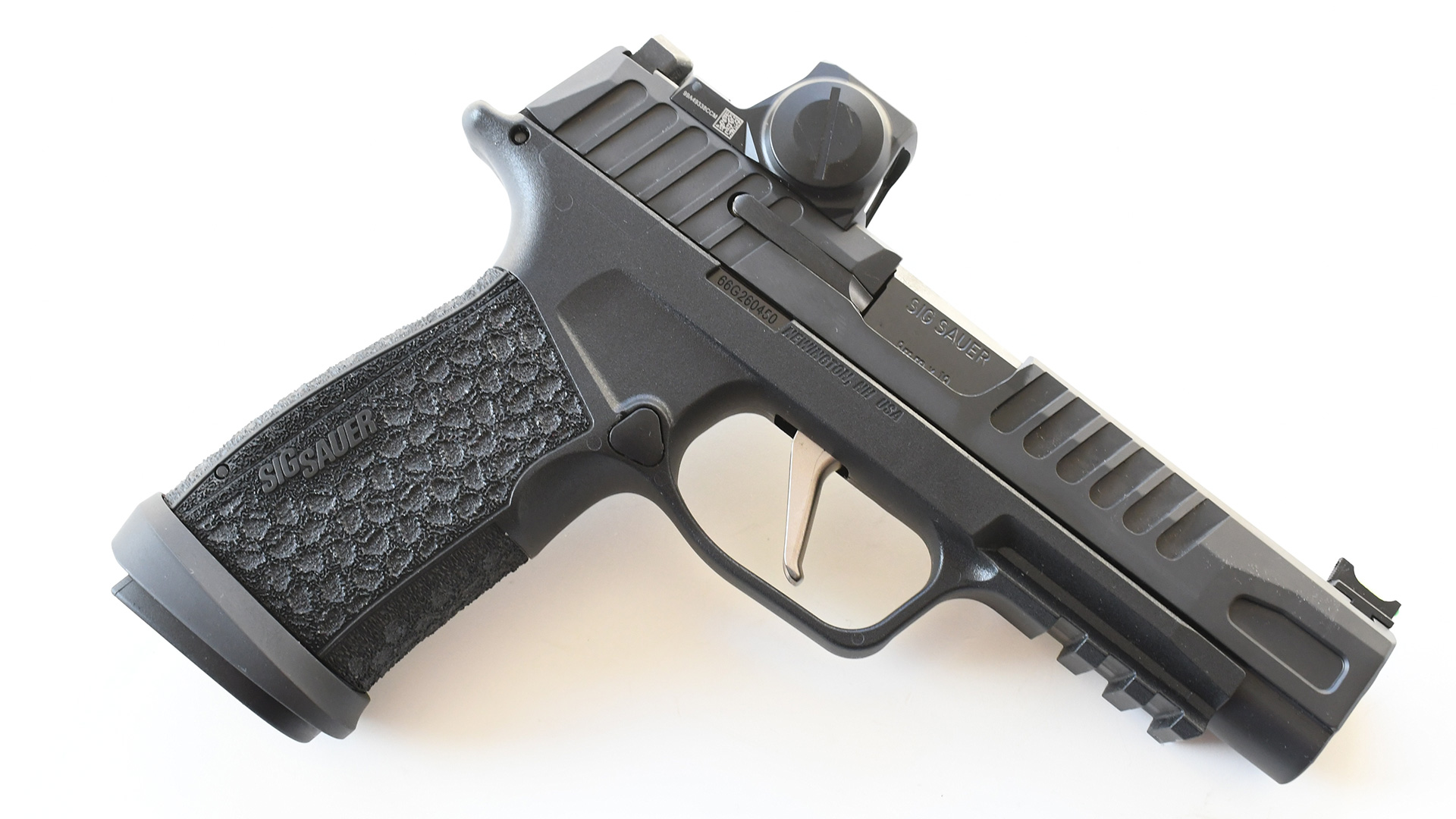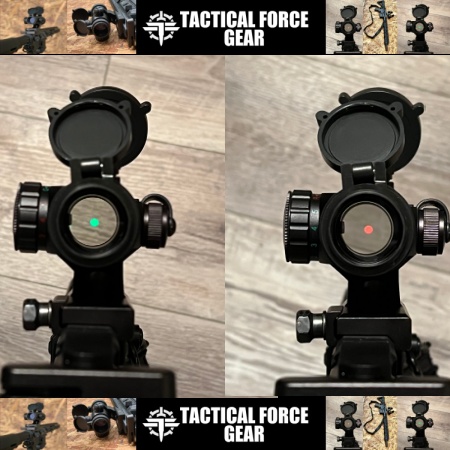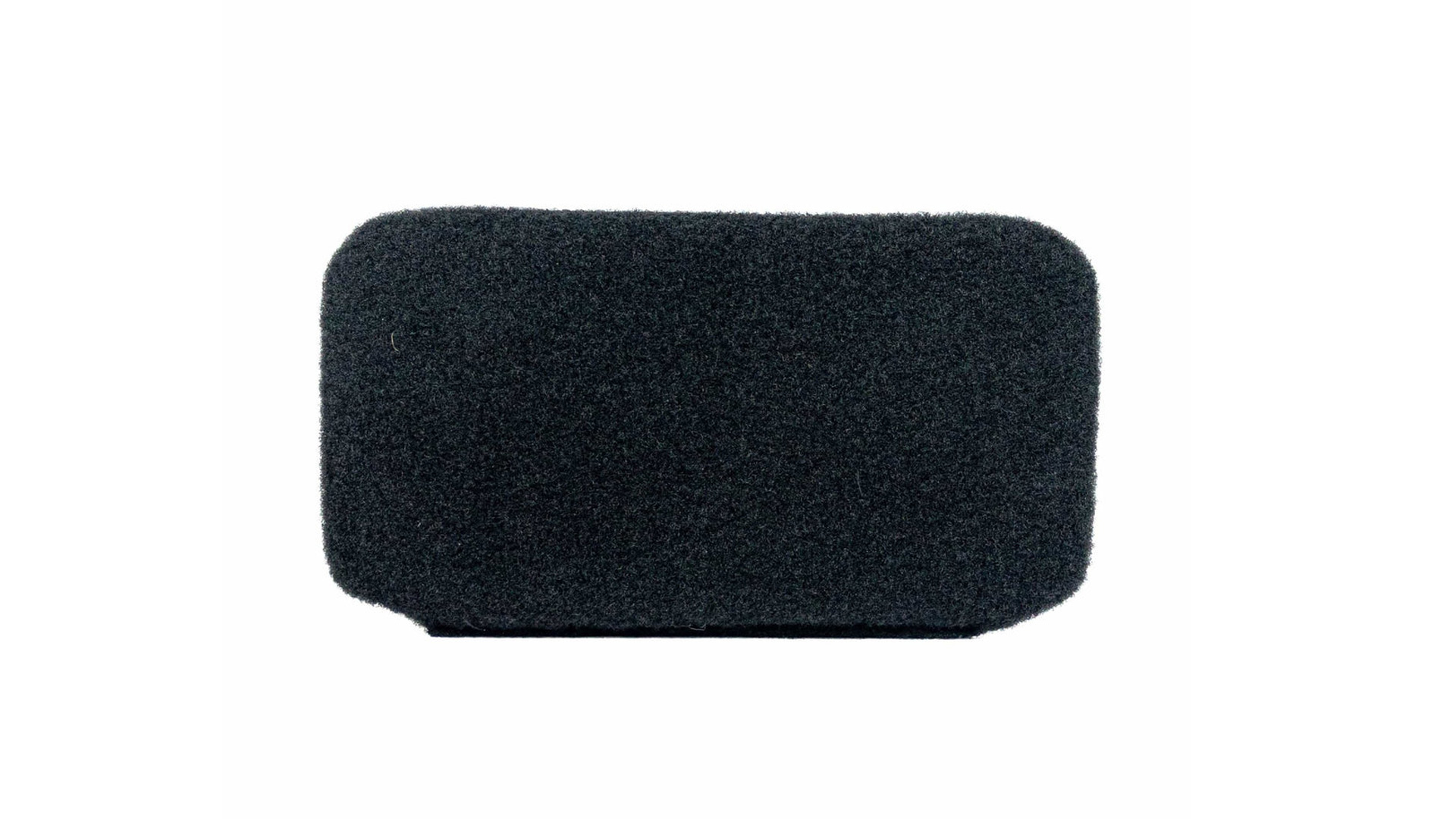The SIG Sauer P365 Fuse is the largest member of SIG Sauer’s extensive P365 product family and is a full-featured, optics-ready, striker-fired, polymer-frame 9mm pistol with a 4.3-inch carbon steel barrel and a 17-round capacity.
Like virtually every other modern semi-automatic pistol, the SIG P365 Fuse operates on the tilting delayed blowback principle. Despite its overall size and capacity, the Fuse retains the same narrow width that the original P365 models are known for. For example, at its widest point, the P365 Fuse measures 1.125 inches across. Besides the thinner frame, the Fuse’s details overlap squarely with all of the industry’s frontline 9mm standard-width duty pistols, like the Smith & Wesson M&P M2.0, the Glock G17, HK VP9, and others, especially with features like the 17-round standard capacity, barrel lengths longer than 4.25 inches and similar overall lengths. The only area where the Fuse stands out is in its lack of width.
P365 Fuse Grip Module
The P365 Fuse’s FCU (fire control unit) is cradled inside a full-size polymer LXG grip module with a natural grip angle that is around what some call the “goldilocks” 18 to 20 degree angle. This grip angle causes the gun to sit in the hand neutrally and present the sights to the target on the draw. Other than the laser-engraved LXG texturing, the P365 Fuse’s grip module is virtually identical in size and dimensions as that of the P365 X-Macro’s.
Using the ubiquitous Glock G48 as a comparison point, the Fuse is actually a tad longer, but not by much. Grip wise, the P365 Fuse is more congruent with the Glock 17’s grip as it’s easy to fit the three extra fingers of the strong hand over the frontstrap. The LXG surface texture offers a decent amount of traction without being too abrasive. The sides of the grip, frontstrap and backstrap all have the “LXG” laser texturing treatment. Upon my first glance, I found it reminiscent of a home-made stipple job, and that’s probably why it seems to work fine. The divots are randomized in their dispersion and size, and they’ll provide some traction without being overly aggressive to distress cover garments.
As mentioned previously, the frontstrap is roomy and is almost the same size as that of full-size Glock pistols. Like all other P365 grip modules, this one retains the signature triangular-shaped mag catch and the gentle scallop over the frontstrap just ahead of the junction with the trigger guard–itself also present with a gentle undercut and a flat bottom portion that’s conducive to building a solid firing-grip. There’s an accessory rail on the front of the grip module that’s compatible with tactical lights like the Streamlight TLR-7 series and others.
P356 Fuse Optics-Ready Slide, Sights and Barrel
The Fuse’s top half is its most feature-rich area. In addition to being milled for the Shield RMSc footprint from the factory, the nitrided ⅞-inch thick slide has aggressive serrations fore and aft. It’s also topped with a complete set of Dawson iron sights consisting of a green fiber-optic pipe on the front and a modern serrated, squared-notched unit on the rear. While the degree of co-witnessing can vary depending on each individual reflex sight, my SIG P365 Fuse is equipped with the SIG Romeo-X, an RMSc-footprint, open-emitter sight. SIG Sauer’s claims that Romeo-X sights co-witness seamlessly with P365 slides due to their low-deck height. Thus far, it really seems to be the case, since shooting the Romeo-X with the Fuse has been one of my smoothest co-witnessing experiences I’ve had. The Fuse’s 4.3-inch carbon steel barrel has a 1:10-inch twist, a rate suitable for standard 9mm bullet weights that range from 115 to 147 grains.
The P365 Fuse Trigger
The Fuse is equipped with a P365 style flat-trigger, and its nickel coating contrasts nicely with the Fuse’s all-black finish as an accent piece. While perfectly serviceable, I do think this trigger is the biggest point of contention with the P365 Fuse. There’s nothing wrong with it per se, but it breaks differently, and shooting well can take some getting used to. Using my electronic trigger-pull scale and recording 10 trigger pulls, this specific Fuse’s trigger pull weight averaged 5 pounds, 1.4 ounces. Others have described this trigger as having a “false wall” in which the trigger doesn’t reach a clearly defined breaking point. While it doesn’t feel like a double-action revolver trigger, that’s what the pull reminds me of. It keeps traveling to the rear until it just finally breaks, which is why shooters need to be on top of trigger manipulation for this pistol. In terms of defensive purposes, this trigger is wholly suitable and not a hindrance. Again, it just takes some effort to master. I noticed that like the rest of the pistol, the Fuse’s trigger also improves after it begins to wear-in. Dry-fire and live-fire are the best ways to improve it.

Shooting The P365 Fuse
The SIG Sauer P365 Fuse shares many attributes with larger 9mm pistols, but its recoil impulse isn’t one of them. Granted, the Fuse is slimmer and lighter so basic physics warrants that it would feel snappier when shooting. However, I find that the combination of the Fuse’s grip’s extra length and its thinner circumference allows the shooter to build a proper two-handed firing grip that the support-hand can also easily squeeze. Both of these factors go a long way in terms of recoil mitigation and control during shooting. In comparison to most double-stack polymer-frame striker 9mm pistols, the Fuse’s slide rebounds a little faster too; shooting sub .20-second splits with the P365 Fuse was no big deal.
I was fortunate to dovetail this handgun review into my recent weekend training with The Way Forward, where I ran the P365 Fuse through a good portion of a two-day, advanced-concealment pistol class. Even though I had never fired the gun until I showed up to class, I deliberately shot it during the class’ module on target transitions and retreating Bill drills. These exercises involved several instances of drawing and shooting multiple shots under the pressure of a shot-timer–a great way to productively put the Fuse through its paces and get a feel for its character.
At the time I write this part of the review, I’ve fired exactly 300 rounds through this SIG Sauer P365 Fuse with a combination of factory ammo and handloads. I had a couple of sluggish stoppages with factory 124-grain 9mm ammo within the first 100 to 150 rounds while in class, but this issue ironed itself out by simply continuing to shoot. Keeping in mind that I had wiped down and lubricated the P365 Fuse prior to class, I think the pistol just needed a mild break-in. Now that it has seen 300 rounds, the gun’s character has evolved. Racking the slide feels smoother as does actuating the slide-release when reloading with a fresh magazine. Likewise, the trigger feels considerably better after having cycled a few hundred live rounds.
The P365 Fuse’s mechanical accuracy impressed me. During accuracy testing, its 1:10-inch twist carbon barrel showed an affinity for Hornady’s 115-grain Critical Defense JHP loaded with one of Hornady’s more accurate handgun bullets, the XTP. Similarly, it printed some notable groups with HOP Munition’s 147-grain Poly RN–a competition-focused load designed to make minor power factor for action pistol games. Unsurprisingly, it was also the smoothest-shooting round across all ammo types that I officially and unofficially shot through this P365 Fuse. Were I intending to carry the SIG Sauer P365 Fuse defensively, I’d seriously contemplate 147-grain JHP loads like Federal Premium’s HST.
The Takeaway
For the uninitiated, SIG Sauer is somewhat famous for its legions of different P365 models, starting with the original 10-round version. Since its 2018 introduction, the original model was responsible for pushing the P365 series to the top of the best-seller list amongst the “slimmer” CCW-friendly pistols.
The P365 Fuse is particularly interesting because it retains the easy-to-carry slimness of the original P365 while offering the same firepower as most contemporary duty-size handguns. The Fuse isn’t the first “slimmer-but-bigger” gun. That distinction belongs to the Glock 48, which has been on the market for a number of years now. SIG Sauer also has its own experiences selling and marketing the P365 X-Macros, and I think they’re onto something with the P365 Fuse—I’m saying this as someone who’d never spent any serious time with a P365 prior to this specific review.
Putting aside the fact that this pistol still has an overall length 7.2 inches that could hinder concealment for some, the totality of the P365 Fuse’s specifications leave me wondering whether the biggest member of the P365 family could objectively be SIG’s true do-it-all 9mm pistol. Despite not being crazy about its trigger, the rest of the gun’s features make up for it in many ways, especially in terms of a defensive handgun.
SIG Sauer P365 Fuse Specifications:
- Manufacturer: SIG Sauer; sigsauer.com
- Country Of Origin: United States
- Action Type: Striker-fired semi-automatic
- Caliber: 9mm
- Capacity: 17 or 21 rounds
- Frame: Polymer
- Slide: Steel
- Barrel Length: 4.3 inches
- Sights: Drift-adjustable serrated Dawson square notch rear, Dawson fiber-optic front, SIG Sauer ElectroOptics Romeo-X Compact reflex sight
- Trigger Pull Weight: 5 pounds, 1.4 ounces
- Length: 7.2 inches
- Width: 1.1 inches
- Height: 5.1 inches
- Weight: 23.1 ounces
- Accessories: One 17-round magazine, two 21-round magazines. cable lock, documentation, manual
- MSRP: $699, $999 with optic
Read the full article here


















Leave a Reply